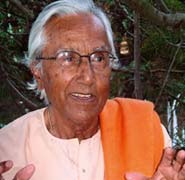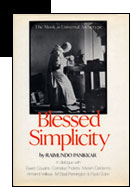

sito ufficiale


Blessed Simplicity
The first edition of this book was published in 1982 (Blessed Simplicity: The Monk as Universal Archtype, New York), with contributions of studies on the work of Panikkar from the likes of E. Cousins, C. Tholens, M. Dardenne, A Veilleux, M.B. Pennington, and P. Soleri, Seabury. Later would come the Catalan editions (1988 and 2000), the German (1989), Italian (1991), Spanish and French (1995, 2000).
We are dealing here with an uncommon format, a book which although it gathers together some previously published work (“The Theandric Vocation”, Monastic studies, New York 1972 and “Letter to a Young Monk”, Living Prayer, Barre 1986), was basically born – as the author recounts in the Introduction – out of a symposium that took place in 1980 in Massachusetts on the theme disclosed in the subtitle: “The Monk as Universal Archetype”; Panikkar’s lectures there and the dialog that followed remain reflected in its pages, although the author is aware that the spoken word is unrepeatable and is not the written word.
The thesis of the book is reflected in both parts of the title: the effort to walk in simplicity (Prov. 10,9) and seek a new innocence helps us live in peace and grow as persons; the monk is the universal archetype of this journey, and as such, can be of worth to the East and West of yesterday and today. The thesis is elaborated in three parts and accompanied by a Prologue.
The first part deals with delineating what is central to “being a monk”, not as an isolated human experience, but rather as human archetype, or more precisely, as one of the ways of realizing the human archetype. The monk archetype represents the polarity between being something difficult and strange and being a vocation for every human being. Panikkar starts out from his personal experience as “a monk without a monastery” and without the robes to arrive at “the monk that is in each of us”, the one who “aspires with his whole being to reach life’s ultimate end”, or simply, to Be. The monastic vocation, thereby, precedes the fact of being Christian, Buddhist, Hindu “or even atheist”.
The second part addresses the monastic vocation as it is today, and forms the fundamental core of the book, elaborating “Nine sutras on the Canon of the disciple” that embark from the basic principle of simplicity: Opening up to the primordial aspiration; The primacy of being over doing and having; Silence; Mother Earth’ Overcoming spacio-temporal parameters; Transhisoric consciousness; Fullness of the person; Primacy of the sacred; Memory of the absolute.
Finally, the third part attempts a synthesis in the form of reflections articulated in four chapters: The intercultural model (the Trinity)’ The sociological challenge; The anthropological problems, and The challenge of secularity.
Beneath the apparent simplicity of the footnote-free text, the richness of this volume increasingly resonates with each of its editions and re-editions in various languages.
translation from Spanish
